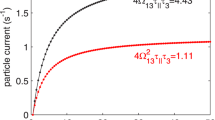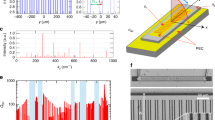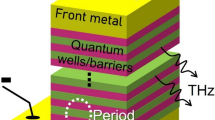Abstract
Advances in semiconductor bandgap engineering have resulted in the recent development of the terahertz quantum cascade laser1. These compact optoelectronic devices now operate in the frequency range 1.2–5 THz, although cryogenic cooling is still required2,3. Further progress towards the realization of devices operating at higher temperatures and emitting at longer wavelengths (sub-terahertz quantum cascade lasers) is difficult because it requires maintaining a population inversion between closely spaced electronic sub-bands (1 THz ≈ 4 meV). Here, we demonstrate a magnetic-field-assisted quantum cascade laser based on the resonant-phonon design. By applying appropriate electrical bias and strong magnetic fields above 16 T, it is possible to achieve laser emission from a single device over a wide range of frequencies (0.68–3.33 THz). Owing to the suppression of inter-Landau-level non-radiative scattering, the device shows magnetic field assisted laser action at 1 THz at temperatures up to 215 K, and 3 THz lasing up to 225 K.
This is a preview of subscription content, access via your institution
Access options
Subscribe to this journal
Receive 12 print issues and online access
$209.00 per year
only $17.42 per issue
Buy this article
- Purchase on Springer Link
- Instant access to full article PDF
Prices may be subject to local taxes which are calculated during checkout




Similar content being viewed by others
References
Köhler, R. et al. Terahertz semiconductor-heterostructure laser. Nature 417, 156–159 (2002).
Walther, C. et al. Quantum cascade lasers operating from 1.2 to 1.6 THz. Appl. Phys. Lett. 91, 131122 (2007).
Lee, A. et al. Real-time terahertz imaging over a standoff distance (>25 meters) . Appl. Phys. Lett. 89, 141125 (2006).
Faist, J. et al. Quantum cascade laser. Science 264, 553–556 (1994).
Devenson, J., Teissier, R., Cathabard, O. & Baranova, A. N. InAs/AlSb quantum cascade lasers emitting below 3 µm. Appl. Phys. Lett. 90, 111118 (2007).
Colombelli, R. et al. Far-infrared surface-plasmon quantum-cascade lasers at 21.5 µm and 24 µm wavelengths. Appl. Phys. Lett. 78, 2620–2622 (2001).
Yu, J. S. et al. Temperature dependent characteristics of λ ∼3.8 µm room-temperature continuous-wave quantum-cascade lasers. Appl. Phys. Lett. 88, 251118 (2006).
Williams, B. S. et al. 3.4-THz quantum cascade laser based on longitudinal-optical-phonon scattering for depopulation. Appl. Phys. Lett. 82, 1015–1017 (2007).
Williams, B. S. et al. Operation of terahertz quantum-cascade lasers at 164 K in pulsed mode and at 117 K in continuous-wave mode. Opt. Express 13, 3331–3339 (2005).
Belkin, M. A. et al. Terahertz quantum cascade lasers with copper metal–metal waveguides operating up to 178 K. Opt. Express 16, 3242–3248 (2008).
Wingreen, N. S. & Stafford, C. A. Quantum-dot cascade laser: Proposal for an ultralow-threshold semiconductor laser. IEEE J. Quantum Electron. 33, 1170–1173 (1997).
Hsu, C. F., O, J. S., Zory, P. & Botez, D. Intersubband quantum-box semiconductor lasers. IEEE J. Sel. Top. Quantum Electron. 6, 491–503 (2000).
Kastalsky, A. et al. Magnetic field-induced suppression of acoustic phonon emission in a superlattice. J. Appl. Phys. 69, 841–845 (1991).
Blank, A. et al. Suppression of intersubband nonradiative transitions by a magnetic field in quantum well laser devices. J. Appl. Phys. 74, 4795–4796 (1993).
Smirnov, D. et al. Control of electron-optical-phonon scattering rates in quantum box cascade lasers. Phys. Rev. B 66, 121305(R) (2002).
Leuliet, A. et al. Electron scattering spectroscopy by a high magnetic field in quantum cascade lasers. Phys. Rev. B 73, 085311 (2006).
Alton, J. et al. Magnetic field in-plane quantization and tuning of population inversion in a THz superlattice quantum cascade laser. Phys. Rev. B 68, 081303(R) (2003).
Scalari, G. et al. Terahertz emission from quantum cascade lasers in the quantum Hall regime: Evidence for many body resonances and localization effects. Phys. Rev. Lett. 93, 237403 (2004).
Pere-Laperne, N. et al. Inter-Landau level scattering and LO-phonon emission in terahertz quantum cascade laser. Appl. Phys. Lett. 91, 062102 (2007).
Becker, C. et al. Electron-longitudinal optical phonon interaction between Landau levels in semiconductor heterostructures. Phys. Rev. B 69, 115328 (2004).
Kohen, S. et al. Electromagnetic modeling of terahertz quantum cascade laser waveguides and resonators. J. Appl. Phys. 97, 053106 (2005).
Sirtori, C. et al. Dual-wavelength emission from optically cascaded intersubband transitions. Opt. Lett. 23, 463–465 (1998).
Franz, I. et al. Evidence of cascaded emission in a dual-wavelength quantum cascade laser. Appl. Phys. Lett. 90, 091104 (2007).
Williams, B. S. Terahertz quantum-cascade lasers. Nature Photon. 1, 517–525 (2007).
Gmachl, C. et al. Recent progress in quantum cascade lasers and applications. Rep. Progr. Phys. 64, 1533–1601 (2001).
Ulrich, J. et al. Magnetic-field-enhanced quantum-cascade emission. Appl. Phys. Lett. 76, 19–21 (2000).
Blaser, S. et al. Terahertz intersubband emission in strong magnetic fields. Appl. Phys. Lett. 81, 67–69 (2002).
Scalari G. et al. THz and sub-THz quantum cascade lasers. Laser Photon. Rev., accepted for publication, DOI: 10.1002/Ipor.200810030, 1–22 (2008).
Acknowledgements
The measurements were performed at the National High Magnetic Field Laboratory supported by the National Science Foundation Cooperative Agreement No. DMR-0084173, by the State of Florida, and by the Department of Energy. The work at Massachusetts Institute of Technology is supported by Air Force Office of Scientific Research, National Aeronautics and Space Administration, and National Science Foundation. Sandia is a multiprogram laboratory operated by Sandia Corporation, a Lockheed Martin Company, for the United States Department of Energy under Contract DE-AC04-94AL85000.
Author information
Authors and Affiliations
Corresponding author
Supplementary information
Supplementary Information
Supplementary Information (PDF 1732 kb)
Rights and permissions
About this article
Cite this article
Wade, A., Fedorov, G., Smirnov, D. et al. Magnetic-field-assisted terahertz quantum cascade laser operating up to 225 K. Nature Photon 3, 41–45 (2009). https://doi.org/10.1038/nphoton.2008.251
Received:
Accepted:
Published:
Issue Date:
DOI: https://doi.org/10.1038/nphoton.2008.251
This article is cited by
-
High-power portable terahertz laser systems
Nature Photonics (2021)
-
Landau level laser
Nature Photonics (2021)
-
Dominant Influence of Interface Roughness Scattering on the Performance of GaN Terahertz Quantum Cascade Lasers
Nanoscale Research Letters (2019)
-
A High-Efficiency 220 GHz Doubler Based on the Planar Schottky Varactor Diode
Journal of Electronic Materials (2019)
-
Optical Properties of Active Regions in Terahertz Quantum Cascade Lasers
Journal of Infrared, Millimeter, and Terahertz Waves (2016)



